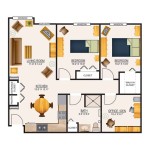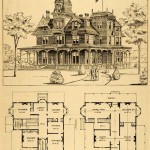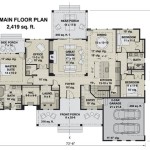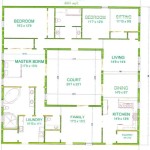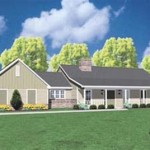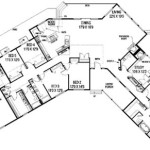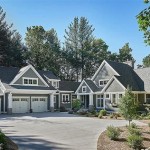```html
Floor Plans For Single Level Homes: A Comprehensive Guide
Single-level homes, often referred to as ranch or rambler-style houses, offer a range of advantages and considerations for prospective homeowners. Their defining characteristic is the absence of stairs, which can be a significant benefit for individuals with mobility challenges, young families, and those seeking a simplified lifestyle. This article explores various aspects of floor plans for single-level homes, examining design considerations, common layouts, benefits, and potential drawbacks.
Careful planning is crucial when designing a single-level home. The floor plan must efficiently utilize the available square footage to accommodate all necessary living spaces. Factors such as lot size, orientation, and local building codes will influence the overall design. Furthermore, attention must be paid to the flow of traffic within the house, ensuring easy access between rooms and maximizing usability.
Accessibility is a prime consideration for single-level homes. Wide doorways and hallways are essential for wheelchair maneuverability and ease of movement for individuals with mobility limitations. Barrier-free showers and strategically placed grab bars in bathrooms can further enhance accessibility. The placement of light switches and outlets should also be considered, ensuring they are within easy reach for all residents.
Key Point 1: Common Layouts and Design Features
Several popular floor plan layouts are frequently employed in single-level homes. One common arrangement is the linear layout, where rooms are arranged along a central hallway. This design is efficient for narrow lots but can sometimes feel less open than other configurations.
Another prevalent layout is the L-shaped design. This configuration provides a natural separation between living areas and bedrooms, offering increased privacy for sleeping spaces. L-shaped designs often incorporate a courtyard or patio area, which can be accessed from multiple rooms, enhancing indoor-outdoor living.
U-shaped floor plans are also utilized, typically surrounding a central courtyard or garden. This design maximizes natural light and ventilation while providing a sheltered outdoor space. U-shaped layouts are well-suited for warmer climates.
Open-concept designs are increasingly popular in single-level homes. This layout combines the living room, dining room, and kitchen into a single, large space, promoting social interaction and creating a sense of spaciousness. Open-concept designs often incorporate large windows and sliding glass doors to further enhance the connection with the outdoors.
Split-bedroom layouts are another common feature found in single-level homes. This design places the master bedroom on one side of the house and the secondary bedrooms on the opposite side, providing increased privacy for the master suite.
Design features to consider for single-level homes include vaulted ceilings, which can create a sense of height and airiness. Skylights can also be incorporated to bring natural light into interior spaces. Fireplaces can serve as focal points in living areas, adding warmth and ambiance.
Key Point 2: Benefits of Single-Level Living
The absence of stairs is arguably the most significant advantage of single-level homes. This feature makes the home accessible to individuals of all ages and physical abilities, including those with mobility impairments, young children, and elderly residents. Stair-free living reduces the risk of falls and injuries, making the home safer for everyone.
Single-level homes can be easier to maintain than multi-story houses. Cleaning, repairs, and landscaping are typically less challenging and time-consuming when all living spaces are on a single level. Exterior maintenance, such as painting and window washing, can also be more easily accomplished on a single-story structure.
Heating and cooling can be more efficient in single-level homes compared to multi-story houses. Because heat rises, multi-story homes often experience temperature discrepancies between floors. In a single-level home, the temperature is more consistent throughout the living spaces, resulting in lower energy bills.
Single-level homes tend to promote a sense of connection and community. The absence of stairs encourages interaction between family members and makes it easier to supervise children. Open-concept layouts further enhance this sense of connection by creating shared living spaces.
Resale value can be a significant benefit, particularly in areas with a growing population of retirees and individuals seeking accessible housing. The demand for single-level homes is increasing in many regions, making them a desirable investment.
Emergency egress is often simpler and faster in single-level homes. All rooms typically have direct access to the outside, facilitating quick and safe evacuation in the event of a fire or other emergency.
Key Point 3: Potential Drawbacks and Considerations
One potential drawback of single-level homes is the requirement for a larger lot size compared to multi-story houses with the same square footage. Because all living spaces are on a single level, the home occupies a larger footprint, necessitating a larger piece of land. This can be a limiting factor in densely populated areas where land is scarce and expensive.
Privacy can be a concern in single-level homes, particularly if windows are located close to neighboring properties or public areas. Careful landscaping and window treatments may be necessary to ensure adequate privacy.
Noise transmission can be more pronounced in single-level homes compared to multi-story houses where bedrooms are often located on a separate floor. Proper insulation and soundproofing measures can help to mitigate noise issues.
Roofing costs can be higher for single-level homes compared to multi-story houses with the same square footage. Because the roof covers a larger area, the cost of materials and labor can be significantly higher.
Security can be a concern in some single-level homes, as all windows and doors are typically accessible from ground level. Security systems, reinforced doors, and window locks can help to enhance security.
The cost per square foot can sometimes be higher for single-level homes. This is due to the increased foundation and roofing requirements compared to multi-story houses. However, the long-term benefits of single-level living, such as reduced energy costs and maintenance, can offset this initial cost.
Lot orientation is paramount for maximizing energy efficiency and natural light in a single-level home. The placement of windows and doors should be carefully considered to minimize exposure to harsh sunlight and maximize ventilation. In colder climates, it's advantageous to orient the home to capture solar heat during the winter months.
Zoning regulations and homeowner association rules can impact the design and construction of single-level homes. It is essential to consult with local authorities and homeowner associations to ensure that the proposed floor plan complies with all applicable regulations.
Proper ventilation is crucial in single-level homes to prevent moisture buildup and maintain good indoor air quality. Adequate ventilation can be achieved through the use of windows, doors, and mechanical ventilation systems, such as exhaust fans and whole-house ventilation systems.
The placement of utilities, such as plumbing and electrical systems, should be carefully planned to minimize disruption and ensure easy access for maintenance and repairs. A central utility core can streamline these systems and make them more accessible.
In conclusion, single-level homes offer numerous advantages for a variety of homeowners. By carefully considering the design, layout, and potential drawbacks, it is possible to create a functional, comfortable, and accessible living space that meets the specific needs and preferences of the occupants.
```
Small One Story 2 Bedroom Retirement House Plans Houseplans Blog Com

Unique One Story House Plans Monster

Stylish One Story House Plans Blog Eplans Com

Elegant One Story Home 6994 4 Bedrooms And 2 Baths The House Designers Plans Floor
Must Have One Story Open Floor Plans Blog Eplans Com

Small One Story 2 Bedroom Retirement House Plans Houseplans Blog Com

Pin On Homes

Stylish One Story House Plans Blog Eplans Com

Single Level 3 Bed House Plan With Split Layout 790024glv Architectural Designs Plans

One Story House Plan Examples

